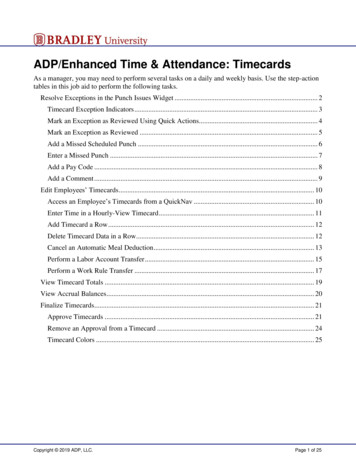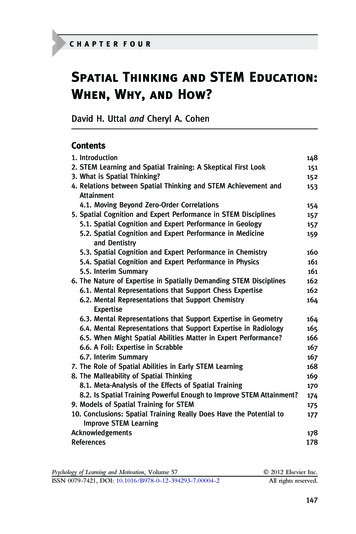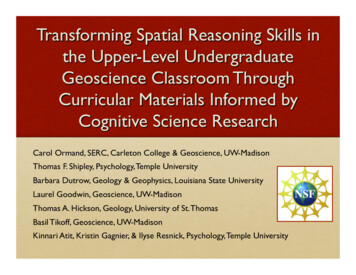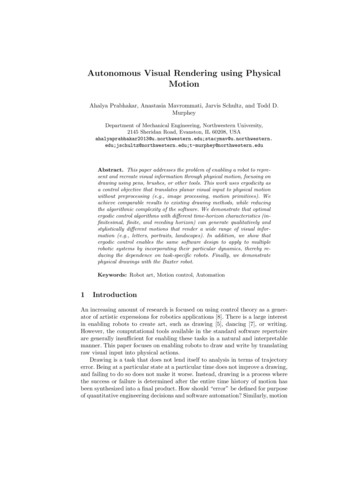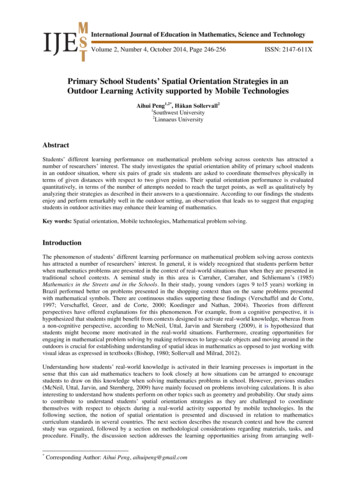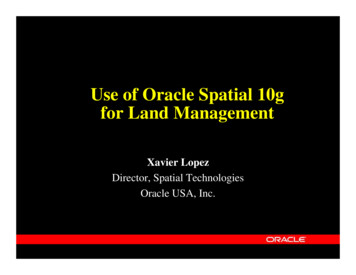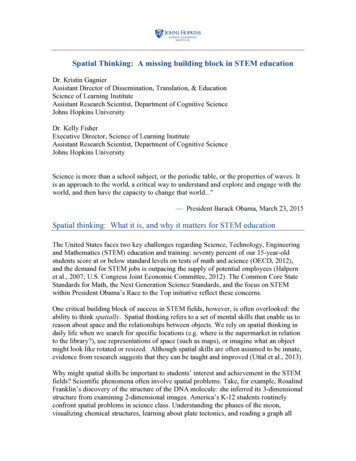
Transcription
Spatial Thinking: A missing building block in STEM educationDr. Kristin GagnierAssistant Director of Dissemination, Translation, & EducationScience of Learning InstituteAssistant Research Scientist, Department of Cognitive ScienceJohns Hopkins UniversityDr. Kelly FisherExecutive Director, Science of Learning InstituteAssistant Research Scientist, Department of Cognitive ScienceJohns Hopkins UniversityScience is more than a school subject, or the periodic table, or the properties of waves. Itis an approach to the world, a critical way to understand and explore and engage with theworld, and then have the capacity to change that world."— President Barack Obama, March 23, 2015Spatial thinking: What it is, and why it matters for STEM educationThe United States faces two key challenges regarding Science, Technology, Engineeringand Mathematics (STEM) education and training: seventy percent of our 15-year-oldstudents score at or below standard levels on tests of math and science (OECD, 2012),and the demand for STEM jobs is outpacing the supply of potential employees (Halpernet al., 2007; U.S. Congress Joint Economic Committee, 2012). The Common Core StateStandards for Math, the Next Generation Science Standards, and the focus on STEMwithin President Obama’s Race to the Top initiative reflect these concerns.One critical building block of success in STEM fields, however, is often overlooked: theability to think spatially. Spatial thinking refers to a set of mental skills that enable us toreason about space and the relationships between objects. We rely on spatial thinking indaily life when we search for specific locations (e.g. where is the supermarket in relationto the library?), use representations of space (such as maps), or imagine what an objectmight look like rotated or resized. Although spatial skills are often assumed to be innate,evidence from research suggests that they can be taught and improved (Uttal et al., 2013).Why might spatial skills be important to students’ interest and achievement in the STEMfields? Scientific phenomena often involve spatial problems. Take, for example, RosalindFranklin’s discovery of the structure of the DNA molecule: she inferred its 3-dimensionalstructure from examining 2-dimensional images. America’s K-12 students routinelyconfront spatial problems in science class. Understanding the phases of the moon,visualizing chemical structures, learning about plate tectonics, and reading a graph all
rely upon understanding spatial information and phenomena. For example, a graph is aspatial depiction of scientific data used to communicate patterns, such as changes inglobal temperatures over time, and comprehending graphs requires the student tointerpret the spatial patterns depicted. In short, students’ spatial capabilities matter fortheir STEM success in school.What the research says Spatial skills in middle and high school predict future STEM successLongitudinal research over the last 50 years suggests that spatial thinking skills arestrongly related to students’ entrance into, retention in, and success within STEMdisciplines (Shea et al., 2001; Wai et al., 2009). For example, the Project Talent studymeasured the spatial thinking skills of 400,000 high school students in a nationallyrepresentative sample in the 1960s and followed them for 11 years after high schoolgraduation. Students with high spatial thinking skills were more likely to choose STEMmajors in college, succeed within those majors, and choose to pursue STEM careers,compared to their peers with low spatial thinking skills. This was true even after forcontrolling for the fact that those students tend to have higher mathematical and verbalskills as well. Other longitudinal studies, in which students’ spatial thinking skills wereassessed in middle school and followed for 20 years (Shea et al., 2001), or in preschooland followed through high school (Wolfgang et al., 2003), present similar findings. Spatial thinking skills can be trainedIntentional training can improve spatial thinking skills in both children and adults, thebenefits of which are enduring and generalizable to new skills (Uttal et al., 2013). Studiespoint to three types of experiences that can facilitate spatial thinking: practicing spatialskills, such as mental rotation (imagining objects rotating in ones head), for a period oftime (e.g. from just 45 minutes to 1 hour per week over 12 weeks); playing video games,such as Tetris, for 1 hour per week for 12 weeks; or participating in semester-longcourses that engage spatial reasoning, such as an engineering drafting course. Suchtraining improves performance among broad spectrum of students: those consideredgifted and talented (Miller & Halpern, 2013), students with both high and low spatialthinking skills (Terlecki et al., 2008), and males and females (Uttal et al., 2013).Spatial skill development has been associated with engagement with spatial playactivities, such as with puzzles, blocks, and shapes, among children under the age of 7(Casey et al., 2008; Jirout & Newcombe, 2015). This association holds even aftercontrolling for other variables, such as parental education, that might influence thisrelationship. For example, 2- to 4-year-old children who played with puzzles during 6observational home visits performed better on a measure of mental rotation at 41/2 yearsold than children who had not played with puzzles during home visits (Levine et al.,2011). This study also found that the frequency of play mattered; children who played
with puzzles more often, tended to perform better. While such studies do not establish acausal relationship, the findings suggest that spatial play, such as with puzzles, mayencourage the development of these skills. Growing evidence suggests that improving students’ spatial thinking can improveSTEM outcomes.Emerging research suggests that bolstering college students’ spatial thinking can improveacademic achievement in chemistry (Small and Morton, 1983), engineering (Sorby,2009), calculus (Sorby et al., 2013), and physics (Miller & Halpern, 2013) coursework. Ineach of these studies, researchers coached students in practicing spatial reasoning andthen measured the effect upon a specific STEM outcome, such as calculus grades,compared to a control group, which had not received spatial training. This work focusedprimarily upon college-aged populations. One study in elementary mathematics, however,showed that 6 -to 8-year-old children improved their accuracy on calculation problemssuch as 3 10 after having practiced mental rotation for 45 minutes. Children whohad practiced crossword puzzles, in contrast, saw no such improvement (Cheng and Mix,2014). This body of work is promising, but it remains to be seen whether these findingsextend to larger cohorts of students and whether STEM outcomes can be improved byother methods, such as explicitly incorporating spatial thinking exercises into math andscience curricula. Spatial skills are an important component of school readiness and early mathskills.There is an apparent link between early mathematics skills and spatial reasoning, whichsuggests that the latter forms a component of school readiness (Verdine et al., 2014a).For example, block-building skills are related to emerging math skills in pre-schoolchildren (Verdine et al., 2014b). In one study, the research team gave three-year-olds ablock model (several different colored mega-blocks pieces, arranged in a specificconfiguration) and asked them to recreate the model using individual blocks. The teamthen compared accuracy on this task with general mathematical ability, such as askingchildren to count as high as they could without making a mistake or giving the researchera specific number of objects, such as 4 crayons. The children who copied the block modelmore ably performed better on the math tasks. This finding is not causal, but it suggeststhat the relationship between spatial skills and math achievement begins as early as age 3.Conclusions and ImplicationsSpatial thinking skills are an important building block of scientific thinking. There isgrowing recognition of the importance of spatial thinking skills for STEM achievementand these skills have begun to appear in education standards, such as the Common CoreState Standards for math and the Next Generation Science Standards. However, verylittle research on spatial thinking has been translated into preK-12 educational practices
and evaluated for effect. As such, many questions remain. Do interventions that targetstudents’ spatial thinking skills lead to improved outcomes in the classroom? What worksin teacher preparation programs in this domain? How does professional development onspatial thinking influence teachers’ attitudes and self-efficacy? Does equipping child-careand pre-K programs with spatially rich education centers that include blocks, puzzles, and2- and 3-dimensional shape games, nurture a capacity and an interest in science andmath? Given our country’s focus on STEM in K-12 education, evaluating the effect ofimproving spatial thinking skills in different classroom contexts could prove a criticaltask that bears long-term fruit for our students.Works Cited:Casey, B. M., Andrews, N., Schindler, H., Kersh, J. E., Samper, A., & Copley, J. (2008). Thedevelopment of spatial skills through interventions involving block buildingactivities. Cognition and Instruction, 26(3), 269-309.Cheng, Y. L., & Mix, K. S. (2014). Spatial training improves children's mathematics ability. Journal ofCognition and Development, 15(1), 2-11.Halpern, D. F., Benbow, C. P., Geary, D. C., Gur, R. C., Hyde, J. S., & Gernsbacher, M. A. (2007). Thescience of sex differences in science and mathematics. Psychological Science in the PublicInterest, 8(1), 1-51.Jirout, J. J., & Newcombe, N. S. (2015). Building Blocks for Developing Spatial Skills Evidence From aLarge, Representative US Sample, Psychological science, 26(3), 302-310.Miller, D. I., & Halpern, D. F. (2013). Can spatial training improve long-term outcomes for gifted STEMundergraduates? Learning and Individual Differences, 26, 141-152.Newcombe, N. S. (2010). Picture This: Increasing Math and Science Learning by Improving SpatialThinking. American Educator, 34(2), 29.Newcombe, N. S. (2013). Seeing Relationships: Using Spatial Thinking to Teach Science, Mathematics,and Social Studies. American Educator, 37(1), 26.OECD (2012). Education at a Glance 2012: OECD Indicators, OECD ea, D. L., Lubinski, D., & Benbow, C. P. (2001). Importance of assessing spatial ability inintellectually talented young adolescents: A 20-year longitudinal study. Journal of EducationalPsychology, 93(3), 604.Small, M. Y., & Morton, M. E. (1983). Research in College Science Teaching: Spatial VisualizationTraining Improves Performance in Organic Chemistry. Journal of College ScienceTeaching, 13(1), 41-43.Sorby, S. A. (2009). Educational research in developing 3-D spatial skills for engineering students.International Journal of Science Education, 31(3), 459–480.Sorby, S., Casey, B., Veurink, N., & Dulaney, A. (2013). The role of spatial training in improving spatialand calculus performance in engineering students. Learning and Individual Differences, 26, 2029.Terlecki, M. S., Newcombe, N. S., & Little, M. (2008). Durable and generalized effects of spatialexperience on mental rotation: Gender differences in growth patterns. Applied CognitivePsychology, 22(7), 996-1013.U.S. Congress Joint Economic Committee (2012). STEM Education: Preparing for the Jobs of theFuture. A Report by the Joint Economic Committee Chairman’s Staff Senator Bob Casey,Chair. April, 2012.Uttal, D. H., Meadow, N. G., Tipton, E., Hand, L. L., Alden, A. R., Warren, C., & Newcombe, N. S.(2013). The malleability of spatial skills: a meta-analysis of training studies. PsychologicalBulletin, 139(2), 352.Verdine, B. N., Golinkoff, R. M., Hirsh-Pasek, K., & Newcombe, N. S. (2014a). Finding the missingpiece: Blocks, puzzles, and shapes fuel school readiness. Trends in Neuroscience andEducation, 3(1), 7-13.
Verdine, B. N., Golinkoff, R. M., Hirsh-Pasek, K., Newcombe, N. S., Filipowicz, A. T., & Chang, A.(2014b). Deconstructing building blocks: Preschoolers' spatial assembly performance relates toearly mathematical skills. Child Development, 85(3), 1062-1076.Wai, J., Lubinski, D., & Benbow, C. P. (2009). Spatial ability for STEM domains: Aligning over 50years of cumulative psychological knowledge solidifies its importance. Journal of EducationalPsychology, 101(4), 817.Wolfgang, C., Stannard, L., & Jones, I. (2003). Advanced constructional play with LEGOs amongpreschoolers as a predictor of later school achievement in mathematics. Early ChildDevelopment and Care, 173(5), 467-475.
ability to think spatially. Spatial thinking refers to a set of mental skills that enable us to reason about space and the relationships between objects. We rely on spatial thinking in daily life when we search for spec
